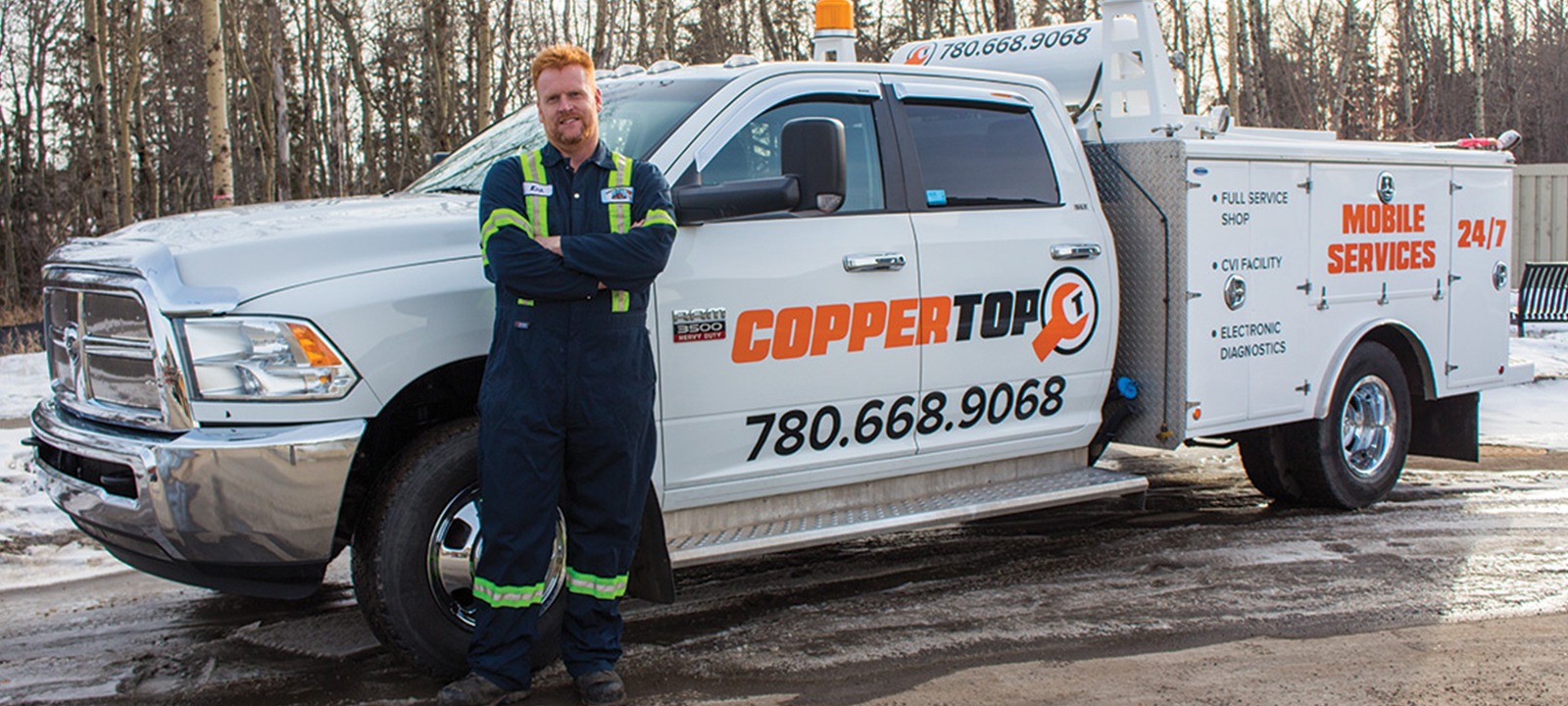
ABOUT COPPERTOP
Coppertop Truck Repair has provided maintenance and repairs to trucks in Edmonton, Alberta, and a wide radius of surrounding areas since 2010. Since day one, Kirk Burchak has poured himself into running Coppertop; he’s mechanic, owner, and manager, wearing whatever hat he needs to at any given time.
As of 2020, he spends most of his days answering roadside calls in the service truck. A good number of Coppertop’s customers are at least a two-hour drive away; some are as far as four. While he’s out in the truck handling roadside breakdowns, he’s got people back at “home base” tending to the customers who bring their vehicles in for everything from engine rebuilds to taillight changes (and anything in between).
In other words, they’re all busy. During winter – a busy season and a harsh one up in northern Canada – Kirk sleeps in half-hour blocks in the truck in between clients.
WHAT DID COPPERTOP NEED?
By 2019, Kirk knew the shop needed to change the way it handled business. They were using QuickBooks for finances but were dependent on carbon copy work orders and pen and paper to track the immediate daily business in the shop. Lots of paperwork, of course, means lots of places to lose paperwork.
“Looking back,” he says, “it was a disaster.”
Kirk was also facing a growing awareness that the shop’s current practice of “eyeballing” labor times (as opposed to clocking in and clocking out) was causing them to lose money.
Could Fullbay help them set things right?
CHALLENGE #1: PAPERWORK PROBLEMS
The most organized paper-pusher in the world will occasionally lose something important. It’s just the nature of the job; a paper can blow off a clipboard, get stuck to another piece of paper, get accidentally filed, or suffer the indignity of coffee spilled all over it.
In Coppertop’s case, a customer would call asking about an invoice. Kirk would remember doing the work and would search for the invoice, but not find it. It was like there was no record of the work at all.
Confining all your important work to paper can have additional problems. Years ago, a part-time tech forgot to put a turbo on a bill. That’s right. A $6,000 part wasn’t billed for. Kirk realized it six months later. Fortunately, this story has a happy ending; the customer was a regular and they were OK with receiving a big bill six months after the fact. But that’s the kind of problem that can quickly put off a new customer.
“[Before Fullbay] A customer would call looking for an invoice and we knew we did the work but we couldn’t always find the invoice. So we forgot to write it down or it got stuck to another invoice and got filed, or you hop out of the truck and it blows off the clipboard, whatever the case is–things happen. Invoices couldn’t always be found when needed.”
CHALLENGE #2: INVOICE TIMES
A small, highly popular shop like Coppertop can become a victim of its own success. At any given time, they had two sets of work orders coming in: one from Kirk out on the road, and one from the shop’s physical location. Kirk alone could write up 10-15 work orders per day. If the shop handled even roughly the same amount, that’s at least 20 daily work orders.
Kirk’s wife, Cora, took over much of the business side of things and had to manually enter everything into QuickBooks: Unit numbers, parts, prices, and so on. He recalls it took her six hours a day just to do invoices. That’s practically a full-time data entry job, but she still had other stuff to do – like deal with customers. Not surprisingly, Coppertop ended up falling a couple weeks behind on invoicing on any given day.
“Your 30-day accounts are turning into 45-day accounts,” Kirk observed. It’s a common problem for far too many shops.
CHALLENGE #3: LOSING BILLABLE HOURS
A lot of small businesses don’t have a clock in/clock out system. Coppertop’s techs would generally eyeball the clock whenever they began and finished a job, or took a break from one. “I started at 1, and now it’s 2,” they’d think, “so I put an hour on that truck.”
Except it usually doesn’t work out that way.
Things like breaks, ordering parts, searching for parts, and waiting around for authorizations bite into the actual billed time. Kirk eventually worked out that their eyeballing method cost them, on average, 1.5 hours of billable work a day.
“Before fullbay, we were not keeping proper track of time. They would forget to bill for things like getting the truck started and bringing it into the shop … We have a two hour minimum for service calls. [Before Fullbay] I would just charge them for the minimum because I thought that was how long the job took me. When I started clocking in and out of jobs, I realized that sometimes jobs took me 2.15 or 2.25 hours. I started to pay attention to that in Fullbay.”
ENTER FULLBAY
Coppertop was ready to see what heavy-duty shop software could do for them. Even if all Fullbay did was cut down on the time they spent handling invoices, it’d be a sound investment.
As it turned out, Fullbay did a lot more than that.
FASTER INVOICING
Nowadays, when a work order is submitted the customer signs it right away. It lives in the cloud, meaning no one has to go digging through piles of paperwork to find it. There’s no wait time on authorization. Cora no longer had to spend hours a day catching up with data entry.
The snowball effect of slowed down work that could follow searching for this piece of information or that disappeared almost entirely.
Before, Coppertop had to usually mail invoices to a customer. Today, Kirk says, “The customer has his invoice before my taillights fade.”
MORE BILLABLE HOURS
As we mentioned above, Kirk realized that eyeballing his clock in/clock out time left a lot of billable hours on the table. After using Fullbay for just three weeks, he worked out that the shop had recouped about $2700.
“It seems crazy,” he acknowledges, “but it’s what I saw.”
“Fullbay enables us to get more trucks in and out of the shop because now they [technicians] are seeing how much time they have on the truck.”
MORE ACCOUNTABILITY
A surprising “side effect” of Fullbay is that it’s kept the in-shop techs more accountable. Now that they can punch in and out of work orders, they can see exactly how much time they are (or aren’t) spending on a job. Seeing their metrics has encouraged them to work smarter (not necessarily harder), and helped Coppertop run more efficiently.
Kirk recalls one of his techs looking over his numbers and saying, “I didn’t realize how much time I was losing for the company [using the old method] on not really tracking properly.”
Another pleasant side effect, Kirk says, is that Fullbay “takes the emotion out of things.”
Most mechanics probably deal with this from time to time. When you look at a workup, and how much it’s going to cost a customer, you might feel a bit badly for them. Hey, we get it. That’s your humanity emerging: You don’t want to hit someone with a giant bill, particularly if you’re not sure they can afford it. It’s difficult not to get emotionally involved.
But you need to make a living, too. Fullbay makes it pretty black and white, producing the plain facts. It lays out the hours a tech works and everything that goes into a particular work order. “You can still be fair to [your customer],” Kirk says, “but you have to be fair to yourself.”
Removing the emotion from a repair makes it easier to collect exactly what you’re owed on it. It’s kept Coppertop accountable to itself and its employees.
LOOKING TO THE FUTURE
Fullbay helped Coppertop cut out a lot of the time-sucking administrative work. By streamlining its invoicing system and helping techs claim their total hours billed, it sped up the shop’s receivables and increased revenue. Coppertop only started using Fullbay in November of 2019 – so they haven’t even been with us for a year. We’re looking forward to their continued success!
“Because of Fullbay, our profitability has increased 20-30%.”




